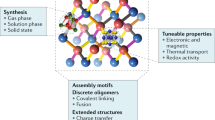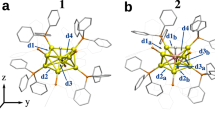Abstract
The quantum states in metal clusters are grouped into bunches of close-lying eigenvalues, termed electronic shells, similar to those of atoms. Filling of the electronic shells with paired electrons results in local minima in energy to give stable species called magic clusters. This led to the realization that selected clusters mimic chemical properties of elemental atoms on the periodic table and can be classified as superatoms. So far the work on superatoms has focused on non-magnetic species. Here we propose a framework for magnetic superatoms by invoking systems that have both localized and delocalized electronic states, in which localized electrons stabilize magnetic moments and filled nearly-free electron shells lead to stable species. An isolated VCs8 and a ligated MnAu24(SH)18 are shown to be such magnetic superatoms. The magnetic superatoms' assemblies could be ideal for molecular electronic devices, as the coupling could be altered by charging or weak fields.
This is a preview of subscription content, access via your institution
Access options
Subscribe to this journal
Receive 12 print issues and online access
$259.00 per year
only $21.58 per issue
Buy this article
- Purchase on Springer Link
- Instant access to full article PDF
Prices may be subject to local taxes which are calculated during checkout





Similar content being viewed by others
References
Khanna, S. N. & Jena, P. Atomic clusters—building-blocks for a class of solids. Phys. Rev. B. 51, 13705–13716 (1995).
Ashman, C. et al. (BAl12)Cs: a cluster-assembled solid. Phys. Rev. B 55, 15868–15875 (1997).
Kumar, V. & Kawazoe, Y. Metal encapsulated icosahedral superatoms of germanium and tin with large gaps: Zn@Ge12 and Cd@Sn12 . Appl. Phys. Lett. 80, 859–861 (2002).
Neukermans, S. et al. Extremely stable metal-encapsulated AlPb10+ and AlPb12+ clusters. Phys. Rev. Lett. 92, 163401 (2004).
Bergeron, D. E., Castleman, A. W. Jr, Morisato, T. & Khanna, S. N. Formation of Al13I−: evidence for the superhalogen character of Al13−. Science 304, 84–87 (2004).
Bergeron, D. E., Roach, P. J., Castleman, A. W. Jr, Jones, N. O. & Khanna, S. N. Al cluster superatoms as halogens in polyhalides and as alkaline earths in iodide salts. Science 307, 231–235 (2005).
Reveles, J. U., Khanna, S. N., Roach, P. J. & Castleman, A. W. Jr Multiple valence superatoms. Proc. Natl Acad. Sci. USA 103, 18405–18410 (2006).
Castleman, A. W. Jr et al. From designer clusters to synthetic crystalline nanoassemblies. Nano Lett. 7, 2734–2741 (2007).
Hartig, J., Stösser, A., Hauser, P. & Schnöckel, H. A metalloid [Ga23{N(SiMe3)2}11] cluster: the jellium model put to test. Angew Chem. Int. Ed. 46, 1658–1662 (2007).
Castleman, A. W. Jr & Khanna, S. N. Clusters, superatoms and building blocks of new materials. J. Phys. Chem. C 113, 2664–2675 (2009).
Knight, W. D. et al. Electronic shell structure and abundances of sodium clusters. Phys. Rev. Lett. 52, 2141–2143 (1984).
de Heer, W. A. The physics of simple metal clusters: experimental aspects and simple models. Rev. Mod. Phys. 65, 611–676 (1994).
Brack, M. The physics of simple metal clusters, self-consistent jellium model and semiclassical approaches. Rev. Mod. Phys. 65, 677–732 (1993).
Janssens, E., Neukermans, S. & Lievens, P. Shells of electrons in metal doped simple metal clusters. Curr. Opin. Solid State Mater. Sci. 8, 185–193 (2004).
Li, X., Wu, H., Wang, X.-B. & Wang, L.-S. s–p hybridization and electron shell structures in aluminum clusters: a photoelectron spectroscopy study. Phys. Rev. Lett. 81, 1909–1912 (1998).
Jadzinsky, P. D., Calero, G., Ackerson, C. J., Bushnell, D. A. & Kornberg, R. D. Structure of a thiol monolayer-protected gold nanoparticle at 1.1 Å resolution. Science 318, 430–433 (2007).
Walter, M. et al. A unified view of ligand-protected gold clusters as superatom complexes. Proc. Natl Acad. Sci. USA 105, 9157–9162 (2008).
Akola, J., Walter, M., Whetten, R. L., Hakkinen, H. & Gronbeck, H. On the structure of thiolate-protected Au25 . J. Am. Chem. Soc. 130, 3756–3757 (2008).
Pederson, M. R., Reuse, F. & Khanna, S. N. Magnetic transition in Mnn (n = 2–8) clusters. Phys. Rev. B 58, 5632–5636 (1998).
Desmarais, N., Reuse, F. A. & Khanna, S. N. Magnetic coupling in neutral and charged Cr2, Mn2, and CrMn dimers. J. Chem. Phys. 112, 5576–5584 (2000).
Tzeli, D., Miranda, U., Kaplan, I. G. & Mavridis, A. First principles study of the electronic structure and bonding of Mn2 . J. Chem. Phys. 129, 154310 (2008).
Dorantes-Davila, J. & Dreysse, H. Magnetic behavior of small vanadium clusters. Phys. Rev. B 47, 3857–3863 (1993).
Song, F. & Bergmann, G. Strongly enhanced magnetic moments of vanadium impurities in thin films of sodium and potassium. Phys. Rev. Lett. 88, 167202 (2002).
Bergmann, G. & Song, F. Electronic transition of vanadium impurities in different alkali hosts. J. Magn. Magn. Mater. 272, E863–E864 (2004).
Sahu, B. R. & Kleinman, L. Nonenhancement of magnetic moments on transition metal impurities by alkali metal hosts. Phys. Rev. B 67, 094424 (2003).
Pradhan, K., Sen, P., Reveles, J. U. & Khanna, S. N. First principles study of Sc, Ti, and V doped Nan (n = 4, 5, 6) clusters: enhanced magnetic moments. Phys. Rev. B 77, 045408 (2008).
Gong, X. G. & Zheng, Q. Q. Electronic structures and stability of Si60 and C60@Si60 clusters. Phys. Rev. B 52, 4756–47595 (1995).
Sattler, K. (ed.) Cluster Assembled Materials (Trans Tech Publications, 1996).
Perez, A. et al. Cluster assembled materials: a novel class of nanostructured solids with original structures and properties. J. Phys. D 30, 709–721 (1997).
Jena, P., Khanna, S. N. & Rao, B. K. (eds) Clusters and Nano-Assemblies (World Scientific, 2003).
Mikhailov, M. N., Kustov, L. M. & Kazansky, V. B. The state and reactivity of Pt6 particles in ZSM-5 zeolite. Catal. Lett. 120, 8–13 (2008).
Khanna, S. N. & Jena, P. Designing ionic solids from metallic clusters. Chem. Phys. Lett. 219, 479–483 (1994).
Reber, A. C., Khanna, S. N. & Castleman, A. W. Jr Superatom compounds, clusters, and assemblies: ultra alkali motifs and architectures. J. Am. Chem. Soc. 129, 10189–10194 (2007).
Zhu, M., Aikens, C. M., Hollander, F. J., Schatz, G. C. & Jin, R. Correlating the crystal structure of a thiol-protected Au cluster and optical properties. J. Am. Chem. Soc. 130, 5883–5885 (2007).
Sessoli, R., Gatteschi, D. & Wernsdorfer, W. Quantum tunneling of the magnetization in molecular nanoclusters in Quantum Phenomena in Clusters and Nanostructures (eds Khanna S. N. & Castleman, A. W. Jr), 55–79 (Springer, 1993).
Zimbovskaya, N. A. & Pederson, M. R. Negative differential resistance in molecular junctions: effect of the electronic structure of the electrodes. Phys. Rev. B 78, 153105 (2008).
Ashman, C., Khanna, S. N., Pederson, M. R. & Kortus, J. Al7CX (X = Li–Cs) clusters: stability and the prospect for cluster materials. Phys. Rev. B 62, 16956–16961 (2000).
Koster, A. M. et al. deMon2 k, V. 2.3.6 (The deMon Developers Community, Cinvestav, México, 2006).
Pederson, M. R. & Jackson, K. A. Variational mesh for quantum-mechanical simulations. Phys. Rev. B 41, 7453–7461 (1990).
Jackson, K. & Pederson, M. R. Accurate forces in a local-orbital approach to the local-density approximation. Phys. Rev. B 42, 3276–3281 (1990).
Porezag, D. & Pederson, M. R. Optimization of Gaussian basis sets for density-functional calculations. Phys. Rev. A 60, 2840–2847 (1999).
Kresse, G. & Furthmüller, F. Efficient iterative schemes for ab initio total-energy calculations using a plane-wave basis set. Phys. Rev. B 54, 11169–11186 (1996).
Kresse, G. & Furthmüller, F. Efficiency of ab-initio total energy calculations for metals and semiconductors using a plane-wave basis set. Comp. Mater. Sci. 6, 15–50 (1996).
Kresse, G. & Joubert, D. From ultrasoft pseudopotentials to the projector augmented-wave method. Phys. Rev. B 59, 1758–1775 (1999).
Acknowledgements
We gratefully acknowledge support from the US Department of the Army through a MURI grant. Parts of the computations were performed at the cluster computing facility at the Harish-Chandra Research Institute, and on the computational equipment of La Dirección General de Servicios de Cómputo Académico de la Universidad Nacional Autónoma de México, particularly at the super computer KanBalam.
Author information
Authors and Affiliations
Contributions
All the authors discussed the results and commented on the manuscript.
Corresponding author
Supplementary information
Supplementary information
Supplementary information (PDF 724 kb)
Rights and permissions
About this article
Cite this article
Reveles, J., Clayborne, P., Reber, A. et al. Designer magnetic superatoms. Nature Chem 1, 310–315 (2009). https://doi.org/10.1038/nchem.249
Received:
Accepted:
Published:
Issue Date:
DOI: https://doi.org/10.1038/nchem.249
This article is cited by
-
Structural Features, Superatomic Properties, and Adsorptions of Zn–Cd Nanoalloy
Journal of Cluster Science (2024)
-
From Atomic Physics to Superatomic Physics
Journal of Cluster Science (2023)
-
Organic ligand mediated evolution from aluminum-based superalkalis to superatomic molecules and one-dimensional nanowires
Nano Research (2022)
-
Spin accommodation and reactivity of nickel clusters with oxygen: Aromatic and magnetic metalloxocube Ni13O8±
Nano Research (2021)
-
Superatoms in materials science
Nature Reviews Materials (2020)



